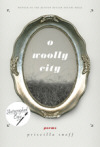O Woolly City
You’re in an abandoned house. The floorboards are damp and creak under you – what was the reason, again, you decided to go bare-footed? And once in a while something brushes against your face. Sometimes it’s the stray end of a cobweb, sometimes the rusty pull-chain to the chandelier. Sometimes you don’t know. Of course, the lights don’t work. You’re not quite ready to leave, but you’re starting to look for a way out. Sometimes you find stairs going up to strange cupboards; other times the stairs bear you down into musty basements.
You’re in an abandoned house. The floorboards are damp and creak under you – what was the reason, again, you decided to go bare-footed? And once in a while something brushes against your face. Sometimes it’s the stray end of a cobweb, sometimes the rusty pull-chain to the chandelier. Sometimes you don’t know. Of course, the lights don’t work. You’re not quite ready to leave, but you’re starting to look for a way out. Sometimes you find stairs going up to strange cupboards; other times the stairs bear you down into musty basements.
For illumination, you’re using Priscilla Sneff’s first book of poetry, O Woolly City, a flickering flashlight of a book. Luckily, Sneff lives in an older world, a time littered with the clinker dust left behind by archeologists, scientists, and classicists. The words she uses to delineate that world come calibrated and weighed, dusted with history’s filmy detritus, offering moments both resonant and unidentifiable, like rare bones found intact in a mass of loess. Her ground is marked off by the elegantly-observed forms of her poems, though the buried bodies they lead to are occasionally too dry and delicate to withstand hearty examination.
That’s not always a bad thing. All of our sciences – and arguably our arts – begin with experiment, which by its nature is fated to fill a few dusty closets with what doesn’t work. What’s surprising in Sneff’s work is not the presence of lesser experiments, of poems leaning too hard on the arm of derivation or becoming lost in the archives of poetic form, but the number and range of poems that succeed in haunting.
“Song,” for example, gleams with quiet control and delightful rhythmic surprises:
Whether he live or no
The meadows shimmer as ever
And heat render the long stems low
And the sun stroke the river
And silence takes me in
Undoubling its front door
To a room like the room inside my skin,
Its broken furniture
And I lie on the single bed
Older; the brown linen is taut
My own bare arm lies under my head
Shifting little or not
When night calls to its own,
Ruffling its owls together,
And their eyes blink in the shining moon,
And the moon glows in the river.
What else does Sneff keep in the deep bins of her hypothetical agora stand, offered for sale to shoppers courting seductive surprise? Lyricisms. Ballads. Lullabies and prose poems, Pastorals, elegies, and spare little things that totter like skeletal fawns on astonishingly fine legs. The manuscript comes sectioned into five portions, each of which displays its own syntax and emphasis while adhering to general thematic threads of shifting change, developing expression, and mutating modes of language.
Sneff displays sensitivity to language as its own entity, as in poems like “The White Stone,” where she writes, “Word, and words, and fuck / Words slip-up in a wave-slap, the black and glass / Waterwings that seabirds ride the backs of.” Again, in “Advice to Penelope”: “Snap the looms into Lego-sticks, confound, misline / The knitting needles into elbowed clackers; / Broider-hoops beat down to cellulose, and pack / Your thimbles into nutprincecrackers.”
In other places, it’s the precision of imagery that awes more than the density of wordplay and language, as in “Poem,” where she writes, “And here is my heart, it’s something I’ve grown / In a rib-cage life climbed up then down on, some ladder.”
Often the images seem referential and more rooted in classicism and oft-favored poetic expressions, as in “Colloquia,” where Sneff writes, “Here Christ Pantokrator flares against bleu du ciel…the small, pale astonished moonfaces of immured nuns are borne here on a tide of black habits pouring like darkness itself through the stone corridors of the ancient, the sea-gated,” echoing Pound’s petal-faces and black boughs. I admire Sneff’s skillfulness, but find myself occasionally wishing for her to pursue with more elegant savagery the flashes of originality she showcases elsewhere.
Those who mull this book over are sure to find vivifying richness of form, allusion, and textual layering. And at the bottom of it all, after searching through Sneff’s bins and attics and archeology sites, we’re left impressed with a deceptively simple beauty. At the risk of begging the collection’s title, the word “woolly” might be a keystone to comprehending Sneff’s artfulness. In her poems, the word seems to describe not only her layering of colloquial and classical, but also the way the world’s dust and laundry lint transform ordinary objects into strangeness. This linguistic shagginess adds mystery as it weaves itself into poetic shapes you’d wish to neither shear nor sacrifice.
Sneff perhaps sums it up best herself in “Poem,” with the words, “I hear in the deep night the I love of ghosts.” After reading O Woolly City, so do we.





